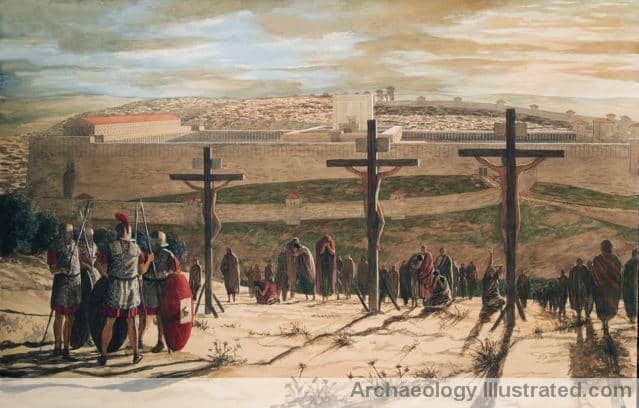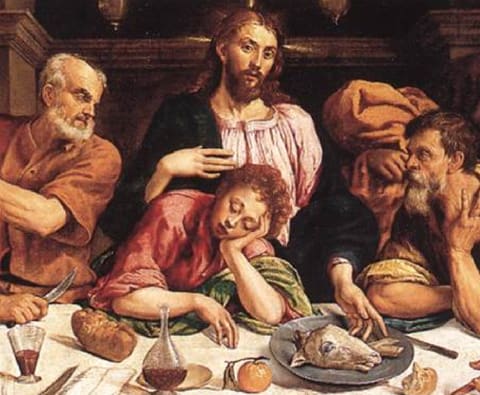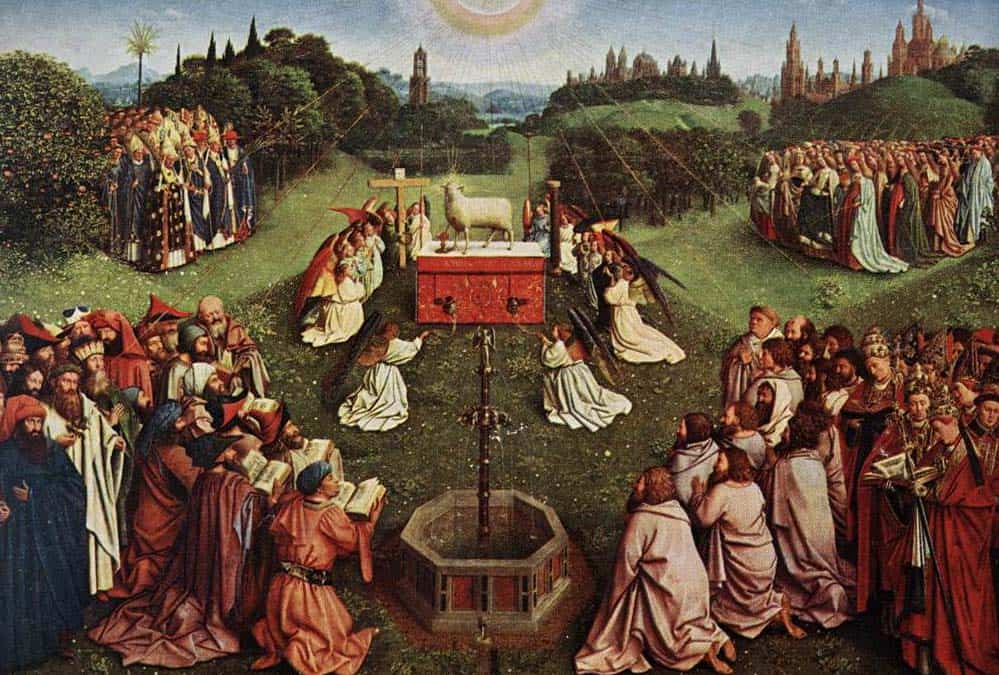Subscribe to TaborBlog in the Sidebar and don’t miss a single post
Of the Twelve apostles it is noteworthy that the only ones not named in the Gospel of John are the “other” James, the “other” Jude, and the “other” Simon, and Matthew–all members of the Jesus Family.
The disciples said to Jesus, “We know you will leave us. Who is going to be our leader then?” Jesus said to them, “No matter where you go you are to go to James the Just, for whose sake heaven and earth came into being.” (Gospel of Thomas 12)
This post, initially written some years ago, has ended up drawing more readers than any other post in decade long history of my blog. This says something about the extraordinary interest in this unnamed disciple of Jesus who shows up mysteriously in the Gospel of John at the Last Supper, at the foot of the cross as Jesus is dying, at the empty tomb on Sunday morning, and finally–and most important–on the Sea of Galilee when Jesus appears to his disciples. Who is this person? Why is he unnamed? Why would Jesus deliver his own mother into the hands of this disciple with his dying breath? In that final scene the editors/authors of the Gospel of John add a most extraordinary affirmation: This is the disciple who is bearing witness to these things, and who has written these things; and we know that his testimony is true (21:24).
In my book The Jesus Dynasty (Simon & Schuster, 2006) I offer my reasons for thinking that the enigmatic figure in the Gospel of John, described as “the disciple whom Jesus loved,” or more commonly, the “Beloved Disciple,” is none other than James the brother of Jesus. I am not sure who has suggested this over the years but I first encountered the idea from Robert Eisenman. [1]See his book James the Brother of Jesus, p.992n28/p. 120.

The traditional view that the Beloved Disciple was the fisherman apostle John, one of the sons of Zebedee can be traced back as early as Irenaeus (c. 180 CE) and was made part of the official Church History of Eusebius in the early 4th century. [2]Church History 6. 25. This identification, however “beloved” to so many, seems highly unlikely. After all, from the few stories we have about John son of Zebedee, he has a fiery and ambitious personality—Jesus had nicknamed him and his brother the “sons of Thunder.” They are the two that had tried to obtain the two chief seats on the Council of Twelve, one asking for the right hand, the other the left. On another occasion they asked Jesus for permission to call down fire from heaven to consume a village that had not accepted their preaching (Luke 9:54). On both occasions Jesus had rebuked them. The image we get of John son of Zebedee is quite opposite from the tender intimacy of the “disciple whom Jesus loved.” No matter how ingrained the image might be in Christian imagination, it makes no sense to imagine John son of Zebedee seated next to Jesus, and leaning on his breast.

Eusebius also mentions another John, “the Elder,”perhaps the author of the New Testament letters of 2nd and 3rd John, whom some have seen as a more likely candidate than John the son of Zebedee [3]Eusebius, Church History 5. 24. This view has been recently defended by Richard Bauckham in his massive study, Jesus and the Eyewitnesses. A good summary of the arguments pro and con for these two Johns as the “beloved disciple” is on-line here.
Today there are several dozens of books in print suggesting various alternative identifications. Ben Witherington and others have suggested Lazarus, brother of the sisters Mary and Martha, whom Jesus raises from the dead in the gospel of John, see here. In the gospel the sisters send word to Jesus, “Lord, he whom you love is ill” (John 11:3). This view has received some possible support from the fragment of “Secret Mark” that Morton Smith found. Mary Magdalene has also become a suggested candidate, despite the use of the masculine pronouns, see Ramon Jusino’s paper here. Most recently it has been suggested that an unnamed “son” of Jesus, whose identity had to be hidden, was the Beloved Disciple, see here. Although I find this view fascinatingly attractive on one level it seems short on evidence and it is hard to imagine Mary the mother of Jesus being delivered into the hands of a son who would have to have been a young adolescent in 30 CE–especially with Jesus’ four brothers on the scene who surely would have been responsible enough to take care of their own mother. In the only text we have that mentions Mary “after the cross” she is grouped with the brothers of Jesus (Acts 1: 14). Some scholars have viewed the “beloved disciple” as a literary construction representing the “ideal disciple,” with no specific identity. James Charlesworth surveys all the possibilities with a full history of scholarship in his landmark book The Beloved Disciple, which I recommend as the best place to begin for readers with a serious interest in this question. Charlesworth ends up arguing for the apostle Thomas, an identification that I think is unique with him, while he is apparently unaware of the possibility of James the brother of Jesus–a choice that has not been part of the mainstream discussion.
Let’s take a look at the text themselves. The Gospel of John mentions the Beloved Disciple in only four scenes, all at the end of his narrative: at the Last Supper, at the Cross, at the empty Tomb, and on the Sea of Galilee after Jesus’ resurrection. Since he is never mentioned earlier we really have very little to go on. Here are the texts in the RSV translation:
1) John 13:23-25: One of his disciples, whom Jesus loved, was lying close to the breast of Jesus; so Simon Peter beckoned to him and said, “Tell us who it is of whom he is speaking.” So lying thus, close to the breast of Jesus, he said to him, “Lord, who is it?”
2) John 19:26-27, 34-35: When Jesus saw his mother, and the disciple whom he loved standing near, he said to his mother, “Woman, behold, your son!” Then he said to the disciple, “Behold, your mother!” And from that hour the disciple took her to his own home…But one of the soldiers pieced his side with a spear, and at once there came out blood and water. He who saw it has borne witness — his testimony is true, and he knows that he tells the truth — that you also may believe.
3) John 20:2-8 So she [Mary Magdalene] ran, and went to Simon Peter and the other disciple, the one whom Jesus loved, and said to them, “They have taken the Lord out of the tomb, and we do not know where they have laid him.” Peter then came out with the other disciple, and they went toward the tomb. They both ran, but the other disciple outran Peter and reached the tomb first; and stooping to look in he saw the linen cloths lying there, but he did not go in. Then Simon Peter came, following him, and went into the tomb. . . Then the other disciple, who reached the tomb first, also went in. . .
4) John 21:1, 7, 20-24 After this Jesus revealed himself again to the disciples by the Sea of Tiberias; and he revealed himself in this way. 2 Simon Peter, Thomas called the Twin, Nathanael of Cana in Galilee, the sons of Zebedee, and two others of his disciples were together…That disciple whom Jesus loved said to Peter, “It is the Lord!” When Simon Peter heard that it was the Lord, he put on his clothes, for he was stripped for work, and sprang into the sea…Peter turned and saw following them the disciple whom Jesus loved, who had lain close to his breast at the supper and had said, “Lord, who is it that is going to betray you?” When Peter saw him, he said to Jesus, “Lord, what about this man?” Jesus said to him, “If it is my will that he remain until I come, what is that to you? Follow me!” The saying spread abroad among the brethren that this disciple was not to die; yet Jesus did not say to him that he was not to die, but, “If it is my will that he remain until I come, what is that to you?” This is the disciple who is bearing witness to these things, and who has written these things; and we know that his testimony is true.
It is also possible that the Beloved Disciple is mentioned in John 18:15 though he is not given that designation: “Simon Peter followed Jesus, and so did another disciple. As this disciple was known to the high priest, he entered the court of the high priest along with Jesus, while Peter stood outside at the door. So the other disciple, who was known to the high priest, went out and spoke to the maid who kept the door, and brought Peter in.”
Based on these texts I would make the following points:
1. The Beloved Disciple is a male, not a woman, and since Mary Magdalene arrives at the tomb and then runs to tell Peter and this “other disciple” whom Jesus loved, the news of the empty tomb, “he” cannot be Mary Magdalene.
2. It is unlikely that the Beloved Disciple is anyone mentioned by name in the Gospel of John, and especially in these latter chapters, 13-21. His identity is being veiled not revealed with a name. That means we can eliminate those mentioned in John 21:1-2, as well Philip, Andrew, and Judas Iscariot of the Twelve, but also Lazarus I think.
3. If we accept the reference in John 18:15 as referring to our figure, the Beloved Disciple seems to have priestly connections in that he is able to get Peter into the courtyard of the High Priest’s house, knowing the woman at the door.
4. The Beloved Disciple takes Jesus’ mother Mary into his care, when Jesus as the oldest son of the family was formerly responsible for the family as function “head of the house.” He is officially designated as the “son” meaning that he is now to carry on the caretaker function for the household that Jesus no longer could do. Whether this scene at the cross is to be taken as historical fact or not, I think it nonetheless reflects a tradition that Jesus’ mother was passed into the care of one who became the “son” in charge of the family, including his mother. Obviously he is gone from the scene and someone has to take over in terms of leadership in the family and care for his mother.
5. The Beloved Disciple is present at the last supper, and thus, based on Mark at least, possibly one of the Twelve, though John does not specify this, i.e., that the meal was with Jesus and the Twelve alone. The description of this disciple “lying close to Jesus’ breast” at the Last Supper indicates an honored place of proximity and intimacy. Jesus loves all his disciples but this particular one has a special place.
I am convinced that these traditions in the Gospel of John refer to a real person, not a symbolic figure. He should be known to us in other texts and in early Christian tradition by name. If we eliminate characters who are named in these latter sections of the Gospel, particularly Lazarus, Simon Peter, Thomas, Nathanael, Philip, Andrew, and James and John, the two sons of Zebedee, and Judas Iscariot, who is left?
Of the Twelve apostles it is noteworthy that the only ones not named in the Gospel of John are the “other” James, the “other” Jude, and the “other” Simon, and Matthew–all part of the Jesus Family! Jesus has three brothers: James, Simon, and Jude, as well as a fourth, Joseph. I think there might be some evidence, as I point out in The Jesus Dynasty, that Matthew is another brother, possibly even the one otherwise known as Joseph, see my post here on “Sorting out the Jesus Family,” This silence seems more than incidental or accidental.
Given these factors it seems to me that James the brother of Jesus surfaces as the best candidate. He is the one who takes over leadership of the followers of Jesus. The “mother and brothers” of Jesus are mentioned in the book of Acts as if they are intact and together (Acts 1:14). Although Luke is reluctant to name either Jesus’ mother or the brothers, given his emphasis on the dominance of Peter and eventually Paul as the main apostles, that he knows the tradition of the intact Jesus family, together in Jerusalem, gathered with the other followers is surely telling. And all the more so that he later has James as the clear head of the Jerusalem community (Acts 15:12-21). To have some other individual such as Lazarus, or the fisherman John, now functioning as caretaker over the family, just makes no sense at all with James present and functioning as leader of the community.
I present arguments in my book, The Jesus Dynasty, summarized here, that James the brother of Jesus was one of the Twelve, and is referred to otherwise as “James the less,” or “James the young one,” who has a brother named Joses. Mark names “James and Joses” as the two older brothers of Jesus. James the brother of Jesus also is known for his priestly orientation, even though his mother is Davidic if Luke’s genealogy is her own. As I discuss in the book, that line has a strong component of priestly/Levite blood running through it, just as Aaron married Elisheva, the leading princess of Judah. Hegisippus tells us that James wore the white linen of the priest, and a mitre of some type, and was allowed to enter the inner sanctuary of the Temple–perhaps as a representative of the Nazarenes. We also have the tradition in the Gospel of the Hebrews that James was indeed present at the last supper, and that Jesus handed over to him some kind of “garment” that signified his priestly office.
I think it likely that the community that ended up shaping the Gospel of John, as indicated in chapter 21:24, had access to eyewitness materials that originated with James the brother of Jesus. Much as in the case of the Gospel of Thomas, the final product that has come down to us is considerably expanded in Gnostic/dualistic directions and a heavy theological overlay. It is noteworthy that the Gospel of Thomas also highlights James as the one to whom Jesus had passed on his authority:
The disciples said to Jesus, “We know you will leave us. Who is going to be our leader then?” Jesus said to them, “No matter where you go you are to go to James the Just, for whose sake heaven and earth came into being.” (Gospel of Thomas 12)
Certainly the Gospel of Thomas in its present form seems far removed from the theological perspectives of the historical James–so much as we can recover or imagine them. However, scholars such as April DeConick have done much to critically lay out the layers of tradition within the text, tracing the ur-text back to the Jerusalem community of James the Just. [4]See a summary of her work here. I think the same is likely the case with the Gospel of John. The quasi-gnostic, dualistic, “overlay” that characterizes the Gospel of John, especially in the extended “red letter” Discourses of Jesus, are not likely part of the original “eyewitness” tradition of the Beloved Disciple to which the final editors/authors of this work appeal for authority.









Comments are closed.